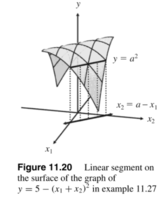hellosoupy
New member
- Joined
- Mar 28, 2021
- Messages
- 13
Hi!
I was just working through an example in my textbook where I obtained the right answer, then they threw me a curveball at the end of their explanation.
The example:
Use the sign of the second-order total differential to show that the function [MATH]y = 5-(x_1 + x_2)^2[/MATH] is concave.
So I found [MATH]f11=f22=f12=f21=-2[/MATH]
therefore
[MATH]d^2y=-2dx_1^2+-4dx_1dx_2+-2dx_2^2[/MATH]
and we can say that y is concave. I get that. But then the textbook mentions the following (I'm copying it nearly verbatim):
"[T]o see that this function is not strictly concave, notice that along the set of [MATH](x_1, x_2)[/MATH] values satisfying [MATH]x_2 =a - x_1[/MATH], where a is any constant, we have [MATH]y = (x_1 + a - x_1)^2 =a^2[/MATH]. These [MATH](x_1, x_2)[/MATH] values generate horizontal linear segments on the graph of this function."
Is there any way to figure out this linear segments bit without looking at the graph of the function? If yes, what would have clued me in to this without looking at the graph? And I still don't understand how that equation indicates that there are linear segments on the graph. Any help would be appreciated!
I actually figured out (by continuing to read through the text) that you can show that this function is concave but not strictly concave using the matrix method, but I'd like to try to wrap my head around the above.
Thanks in advance!
I was just working through an example in my textbook where I obtained the right answer, then they threw me a curveball at the end of their explanation.
The example:
Use the sign of the second-order total differential to show that the function [MATH]y = 5-(x_1 + x_2)^2[/MATH] is concave.
So I found [MATH]f11=f22=f12=f21=-2[/MATH]
therefore
[MATH]d^2y=-2dx_1^2+-4dx_1dx_2+-2dx_2^2[/MATH]
and we can say that y is concave. I get that. But then the textbook mentions the following (I'm copying it nearly verbatim):
"[T]o see that this function is not strictly concave, notice that along the set of [MATH](x_1, x_2)[/MATH] values satisfying [MATH]x_2 =a - x_1[/MATH], where a is any constant, we have [MATH]y = (x_1 + a - x_1)^2 =a^2[/MATH]. These [MATH](x_1, x_2)[/MATH] values generate horizontal linear segments on the graph of this function."
Is there any way to figure out this linear segments bit without looking at the graph of the function? If yes, what would have clued me in to this without looking at the graph? And I still don't understand how that equation indicates that there are linear segments on the graph. Any help would be appreciated!
I actually figured out (by continuing to read through the text) that you can show that this function is concave but not strictly concave using the matrix method, but I'd like to try to wrap my head around the above.
Thanks in advance!

